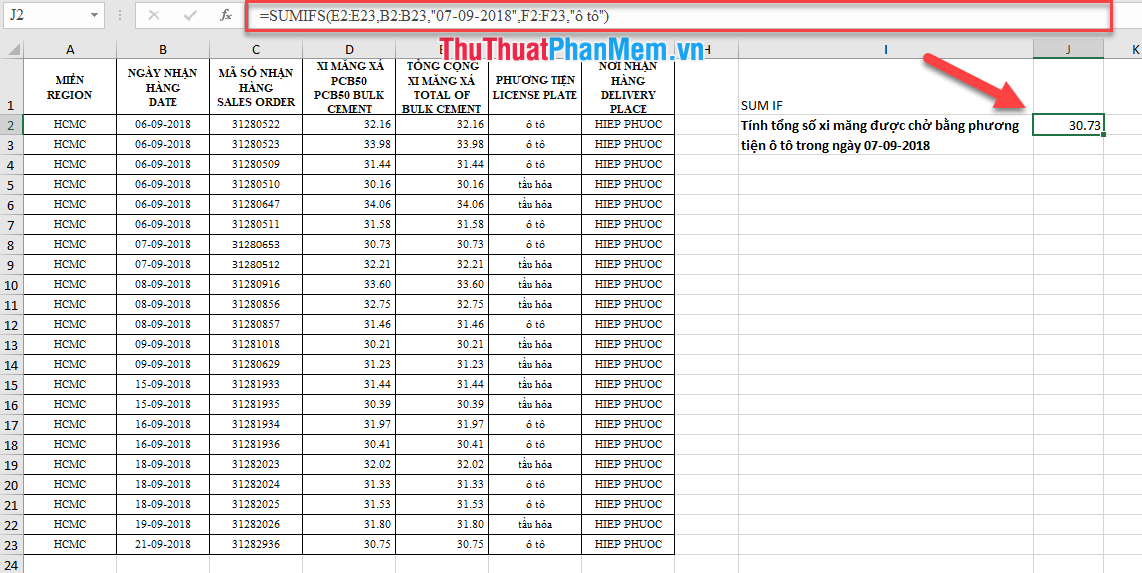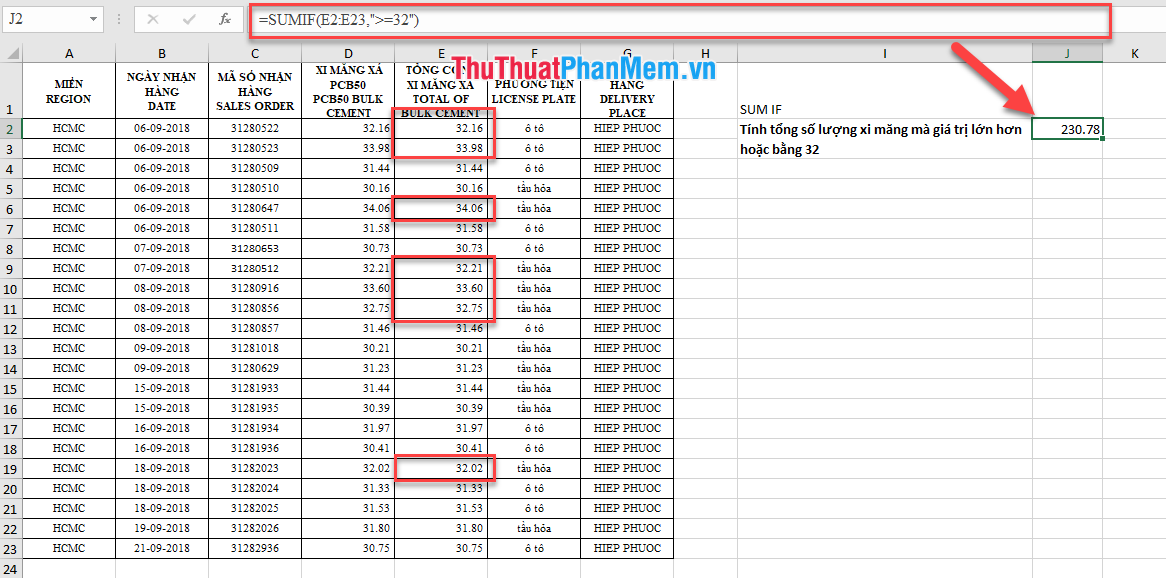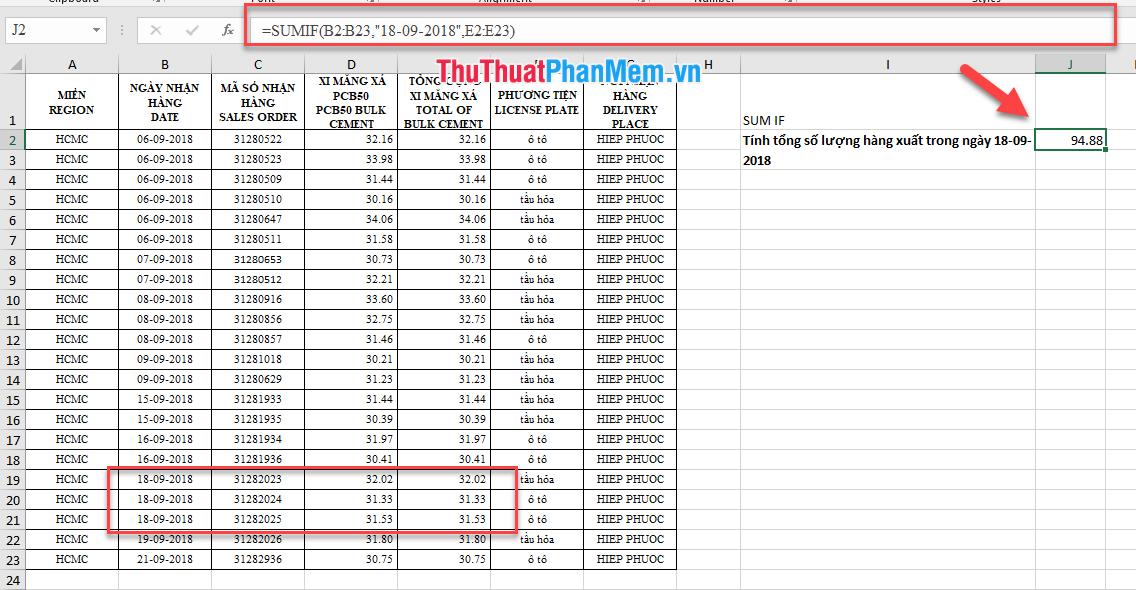How to calculate the total value based on multiple conditions in Excel
To calculate conditional sum in Excel, it is impossible not to mention the special calculation function that is SUMIF and SUMIFS function. In this article, Software Tips will show how to use conditional sum function. Please follow the following article.

Sumif function - Syntax and usage
Function structure: = SUMIF (range, criteria, [sum_range])
Inside:
- SUMIF : The function name used to sum values based on criteria .
- Range : The area of the cells evaluated according to the condition you given.
- Criteria : The condition you put in to sum.
- Sum_range : Optional value, sum cells if satisfying conditions, if no sum_range is entered , Excel will understand the area to be summed is the range of cells evaluated under range condition .
Usage and examples:
For example, you have the following worksheet and need to add the total number of cement (column E) that is transported by car (Column F).
You use the following formula: = SUMIF (F2: F23, "car", E2: E23) and get the following result:

Sumifs function - Syntax and usage
Function structure: = SUMIFS (sum_range, criteria_range1, criteria1, [criter_range2, criteria2], .)
Inside:
- SUMIFS : Function name used to sum values based on multiple criteria1, criteria2… criteria.
- Sum_range : Required value. Sum cells if the condition is met.
- Criteria_range1 : Required value. The area of the cells is evaluated according to the condition that you give.
- Criteria1 : Required value. The first condition must meet to sum.
- Criteria_range2 : Optional value. The area of the cells is evaluated according to the condition that you give.
- Criteria2 : Optional value. The th condition must meet to sum.
Note that the SUMIFS function operates in the logical AND expression, that is, all the conditions must be met in order to sum the cell.
Now let's see how the SUMIFS function works with the two conditions in the following example:

Formulated as spreadsheets, Dexterity Software requirements calculated total cement production by means automobiles of the day 07-09-2018 . And Excel finds a unique value that satisfies the two requirements and returns a value of 30.73 .
Notes when using the SUMIF and SUMIFS functions
Note 1 : Logical expressions compared to operators must be enclosed in quotation marks "".
For example, with the same worksheet above, you need to sum the cells with values greater than or equal to 32, the formula will be applied as follows:

Note 2 : Same as above if you find the condition by date or text format, the condition must be enclosed in quotation marks "".
For example, you need to calculate the total amount of goods exported on September 18, 2018.

Above are instructions and some specific examples when using SUMIFF and SUMIFS functions to calculate the total value on many conditions.
Good luck!
You should read it
- How to format data based on other cell conditions in Excel
- SUM function in Excel: How to use SUM to calculate totals in Excel - SUM function in Excel
- How to use DSUM function in Excel
- How to automatically calculate and copy formulas in Excel
- How to count on multiple sheets of Google Sheets
- How to use SUMIF with 2 or more conditions in Excel
- The SUMIFS function, how to use multiple conditional calculation functions in Excel
- Practical exercise on computer rental list in Excel
May be interested
- How to use SUMIF with 2 or more conditions in Excel
 you already know the sumif function to calculate conditional sum in excel, but you do not know how to use the sumif function with 2 or more conditions in excel. so you let tipsmake.com find out in this article.
you already know the sumif function to calculate conditional sum in excel, but you do not know how to use the sumif function with 2 or more conditions in excel. so you let tipsmake.com find out in this article. - Practical exercise on computer rental list in Excel
 the following article provides detailed instructions for you to practice on how to calculate the values in the computer rental list in excel 2013. for example, the following data table: calculating the amount of computer tenants must pay, calculate the total number of hours rent and the total amount t
the following article provides detailed instructions for you to practice on how to calculate the values in the computer rental list in excel 2013. for example, the following data table: calculating the amount of computer tenants must pay, calculate the total number of hours rent and the total amount t - How to calculate NPV in Excel
 how to calculate npv in excel. npv is the net present value (npv), that is, the net present value of an investment. based on the npv, the investor calculates the difference between the current value of cash inflows and the current value of cash outflows.
how to calculate npv in excel. npv is the net present value (npv), that is, the net present value of an investment. based on the npv, the investor calculates the difference between the current value of cash inflows and the current value of cash outflows. - DATEDIF () function (calculate the total number of years, total months or total days from two given periods) in Excel
 the datedif () function helps you calculate the total number of years, the total number of months, or the total number of days from two given periods.
the datedif () function helps you calculate the total number of years, the total number of months, or the total number of days from two given periods. - The easiest way to calculate the percentage (%)
 calculating percentages on excel doesn't have to use excel functions, it's just a normal calculation. so how to calculate the fastest percentage, and also need the most accurate. the following article will guide you how to calculate the most accurate percentage value.
calculating percentages on excel doesn't have to use excel functions, it's just a normal calculation. so how to calculate the fastest percentage, and also need the most accurate. the following article will guide you how to calculate the most accurate percentage value. - Calculate the subtotal of the list on Excel
 if you don't want to calculate subtotals, the list is a new feature that is very useful in excel 2003; excel always disables the subtotal feature for the list. currently, to be able to manage the list and perform calculations on the total number of dependencies & igr
if you don't want to calculate subtotals, the list is a new feature that is very useful in excel 2003; excel always disables the subtotal feature for the list. currently, to be able to manage the list and perform calculations on the total number of dependencies & igr - Calculate data in a PivotTable in Excel
 calculate data in a pivottable in excel. creating statistical reports using pivottable mainly through numbers: summing up quantity, highest sales, lowest ... therefore, the calculation in pivottable is based on calculating numbers.
calculate data in a pivottable in excel. creating statistical reports using pivottable mainly through numbers: summing up quantity, highest sales, lowest ... therefore, the calculation in pivottable is based on calculating numbers. - Calculation of age from date of birth in Excel
 the following article will guide you how to calculate the age from date of birth in excel so you can calculate the exact number of standard age in years, months and days. in the process of calculating age based on date of birth, the following cases occur: - case 1: calculates the usual age
the following article will guide you how to calculate the age from date of birth in excel so you can calculate the exact number of standard age in years, months and days. in the process of calculating age based on date of birth, the following cases occur: - case 1: calculates the usual age - Calculation of percentages in Excel
 calculating percentages in excel is a basic calculation, with a very simple and quick calculation when you don't need to enter any functions.
calculating percentages in excel is a basic calculation, with a very simple and quick calculation when you don't need to enter any functions. - Practical exercises on Notebook price list in Excel
 the following article gives detailed instructions for you to practice on how to calculate values in notebook price list in excel 2013. for example, there is the following data table: calculating the total amount payable by customers including vat 5%. to calculate the amount the tenant must
the following article gives detailed instructions for you to practice on how to calculate values in notebook price list in excel 2013. for example, there is the following data table: calculating the total amount payable by customers including vat 5%. to calculate the amount the tenant must










 How to correct a #NUM error in Excel
How to correct a #NUM error in Excel How to correct a #NA error in Excel
How to correct a #NA error in Excel How to add pages to a PDF file
How to add pages to a PDF file Top 3 best Chinese percussion for computers
Top 3 best Chinese percussion for computers How to insert background into PowerPoint
How to insert background into PowerPoint Countdown timer collection to insert into Powerpoint
Countdown timer collection to insert into Powerpoint